Do your cannabis plant’s leaves have a rust color?
Are you observing something unusual with your cannabis plant?
Then it may be something serious!
If you spot rust color on your cannabis plant, it indicates that you must do something to save them.
However, there could be single or multiple reasons for having rust spots on leaves during flowering, but you need to address them ASAP as it could harm the overall growth of the cannabis plants.
So, let’s find out the root causes and reasons why weed plant leaves have rust spots and how you can treat them instantly.
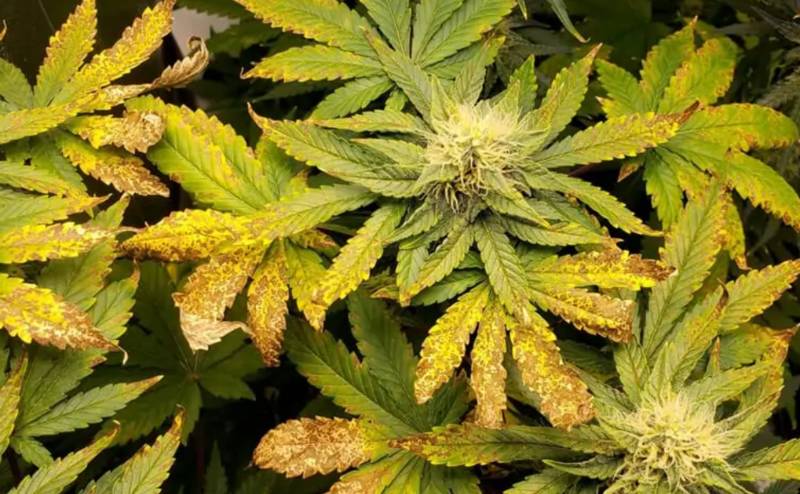
What Are Rust Spots On Leaves During Flowering And Why It Occurred?
Contents
If you find an alien-looking spot or brown spots like those shown in the image, it is more likely to have a fungal infection.
The brown spots you see on rusty leaves or brown spots during flowering are the reservoirs of reproductive spores.
These spores can spread throughout the plant, so you must take action before this issue worsens.
However, the good part is that you can solve fungus-rust issues quickly.
You must address it, find the root cause, and solve it.
5 Major Reasons For Rust Spots On Cannabis Leaves
So let’s discuss the five main reasons cannabis leaves have rust spots. Let’s go through each of the reasons and find the solution:
5. Rust Fungus
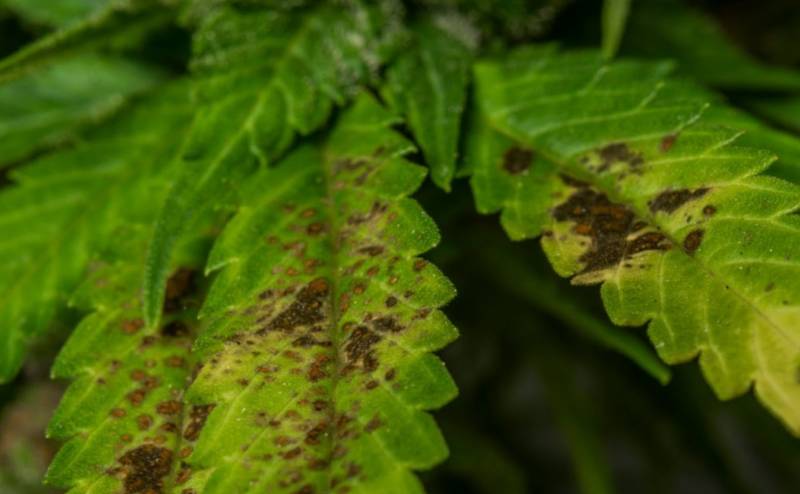
The first and foremost reason you observe rust spots on cannabis leaves may be rust fungus.
Rust fungus happens due to a fungal plant rust parasite that affects plants. And the worst part about this fungal parasite is that it spreads quickly through the airborne fungus.
But unlike fungi, rust fungus affects only living plants, so you must be aware of that.
However, that doesn’t mean this fungus does not damage the plant.
Rust fungus makes your plant have several issues.
Apart from showing rusted color on plant leaves to causing damages such that your plants can’t have proper nutrient absorption are the expected outcomes.
The brown color spots increase with time, and later on, the plant leaves die.
Rust fungus is a common issue with indoor growers, and closet grows. Also, it thrives in growing areas with high humidity and poor ventilation.
And if the plants are close to each other, they can affect or get affected by the other plants.
In the end, rust fungus doesn’t kill your plants but causes several issues that can severely affect the plant’s health.
And the long period of not giving attention to this issue can lead to severe damage to the plant’s health, resulting in low yield, or even can eventually kill the plants if you don’t solve it.
How To Check If Your Plants Have Rust Fungus?
The only good part about this issue is that you can spot it quickly, giving you time to make your plants recover from it if you take the necessary action ASAP.
So how do you check if your plants have rust fungus?
If you spot one leaf with a brown spot, rub your fingers against the rust spot. Now, if the color comes off your finger, if you rust, it indicates that your plants have rust fungus.
And if you don’t observe this symptom, then the other reason could be a nutrient deficiency, which we will discuss further.
However, if you observe this issue by peeling off color by rubbing off your finger, it is most likely due to the fungus.
Let’s find out the reasons for that:
Reasons For Rust Fungus
Rust fungus in cannabis plants occurs when they get high relative humidity (RH level) and long periods of wetness (temperature below 20 degrees Celsius).
That means fungus occurs in moist soil or due to overwatering.
So, keeping the temperature low continuously, along with a wet or moist environment, can be the significant reason rust fungus occurs on your cannabis leaves.
How To Eliminate Rust Fungus?
Eliminating rust fungus once it has infected your plant is tough, but you can take some steps, so it doesn’t affect the other plants.
The first step is to save the other plants from rust infection; therefore, you must throw away all the infected leaves or plants.
Make sure to avoid the contact as much as possible as you need to save other plants as well from this issue
Also, take care while removing the leaves or plants because the spores can infect other plants.
Once you have entirely removed or eliminated the plants infected with fungus, you have almost secured your plants.
Now the next step after removing and disposing of infected leaves is to use a fungicide to treat the remaining plants so that you can remove all the probability of rust fungus rising again.
To do so, you can use chemical-based or even homemade fungicides. You can take the help of online blogs to make it.
However, if you want to avoid the hassle and take quick action, you can order the best fungicide online.
Tips For Preventing Rust Fungus
Once the rust fungus has been developed, you can take the proper steps to remove the maximum rust fungus elements from your indoor garden, as mentioned.
But once you have removed and secured your plant does not guarantee that rust fungus can’t occur again.
Therefore, you need to follow these tips to reduce the chances of rust fungus rising again.
Rust fungus occurs mainly in moist environments, whether the moisture is due to overwatering or temperature drops. So you may think of eliminating the moisture.
But it will not be the right step to prevent rust fungus.
Instead, as a grower, you must be aware that cannabis plants need a slightly humid environment with a relative humidity level of around 30% to 40%, which helps the plants to thrive.
The appropriate way to prevent fungus from developing is to keep the humidity level slightly low or in control, along with providing proper ventilation to your grow room.
The grow tent or room should have cooler night temperatures and proper airflow.
The airflow through the grow space will help prevent rust fungus.
Along with proper air circulation, you can also avoid overcrowding of leaves.
That means you can cut the leaves from time to time during the flowering stage so that the plant’s lower branches get more light for proper growth.
When you cut the excess leaves, it also prevents the growth of mold that may happen due to overcrowding of cannabis leaves.
Moreover, you can also prevent the water splash on your plants and make them avoid the touch to the soil. It is because the rust fungus spreads through wind or water.
Also, keep a certain distance between the plants as rust fungus quickly spreads from one plant to another. Therefore, keeping them at a distance can save your other plants from infection.
Apart from this, if you want to prevent fungal spores, you can use several fungicides available on the market.
They work excellently to avoid and prevent rust fungus, fungal spores, powdery mildew, and other plant-related diseases that you don’t want to happen to your plants.
However, you need to remember that these fungicides work only when your plants are not affected, and you want to prevent these issues throughout the different growth stages.
Once a rust fungus infects the plant, you need to remove that plant to save other plants in the garden, as fungicides will not work.
Then you need to follow the elimination steps for that scenario.
4. Calcium Or Magnesium Deficiency
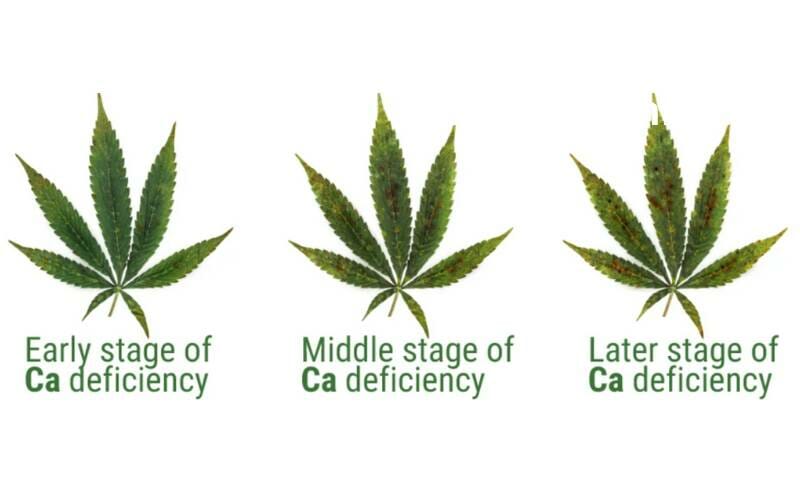
Leaf rust fungi cannot be the sole reason for rust spots on the cannabis leaves during flowering. Apart from it, magnesium and calcium deficiency can also be another possible reason for the same.
Cannabis plants need all the nutrients, including magnesium and calcium, for proper growth.
However, during the flowering stage, plants need these nutrients the most.
And if they are not getting ample nutrients, they may show symptoms such as rust spots on the leaves.
Once the plants begin to show rust spots, and if it spreads over the other leaves, it can cause severe damage to your plant health.
Flower production goes down, and if left unattended for a long time, it can eventually impact the overall yield or even kill the plant.
So if, with the first step, you don’t observe rust fungus on your plants, then there is a possible chance that it may be due to magnesium or calcium deficiency.
So you need to learn about the signs and take appropriate steps to eliminate them.
Symptoms Of Magnesium And Calcium Deficiency
Plant leaves with magnesium or calcium deficiency show symptoms of having brown edges and curly tips.
And if your plants have a nutrient deficiency, you can observe these symptoms. Calcium deficiency issues are not curable. So you can only limit or control its impact of it.
However, if you ignore the problem, it will get worse.
On the other hand, Magnesium deficiency is quite common among plants and can cause more damage than calcium deficiency.
Therefore, you need to figure out if your plants lack any nutrients and provide them before it gets too late.
Nutrient Lockout
Another issue that is quite common and related to nutrient deficiency is a nutrient lockout. It happens due to an increase or decrease in pH level as the pH level affects the absorption of nutrients in the soil.
Therefore, maintaining soil pH becomes essential.
If the pH range in your cannabis plants is not in the ideal range, then your plants will suffer from nutrient lockout.
When the pH level is high (more than 7), your plants will find it difficult to absorb nutrients including essential nutrients such as potassium, phosphorus, nitrogen, etc.
However, if the pH level drops down below 7, then your plants will not be able to absorb magnesium and calcium.
Also, nutrient lockout can happen if the plant roots are subjected to acidic and cold environment, so you need to take care of that.
Additionally, too much ammonium, potassium, or calcium compared to magnesium can also create a nutrient lockout, which needs to be solved quickly.
Solution For Magnesium And Calcium Deficiency
Before jumping into the solution, you need to figure out if your plants are not having nutrient lockout and ensure it is a deficiency.
It is because nutrient deficiency and nutrient lockouts are two different conditions that are opposite.
As said before, calcium deficiency problems are not curable, but you can limit or control the damage that it is causing.
If you don’t pay attention to this issue or don’t find a solution, it can severely affect the growth and the overall yield.
However, you can use other nutrient solutions available for nutrient deficiency issues.
For instance, ILGM fertilizers are one of the popular options among growers. Apart from solving the issues of nutrient deficiencies, you can also keep the nutrients handy for the healthy growth of your plant.
Providing nutrients adequately will reduce the chances of rust spots and other issues due to nutrient deficiency.
However, if you find out that your plants are having issues due to nutrient lockout, you must keep the pH within the required range.
The good pH range is 6.5 to 9.1. However, if the pH range is outside of these limits, then your plants are suffering from the nutrient lockout, which you need to address immediately.
Also, if the pH level is in the required range (around 6.8), you can feed your cannabis-required nutrients, including calcium and magnesium.
But don’t overdo it, as overdoing it can lead to nutrient lockout.
3. Nutrient Burn
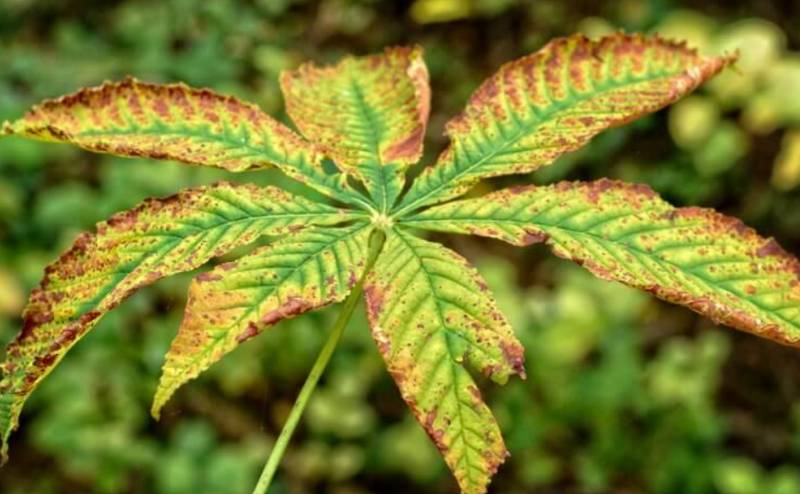
Doubtless, nutrients are essential for plant growth which helps the plants to grow faster and produce a better yield.
But what if you provide too many nutrients to your plants?
It will cause nutrient burn!
And obviously, it is the complete opposite of nutrient deficiency. So if your plants suffer from a nutrient burn, you can observe reddish or brown leaves.
You may also observe cannabis leaves curling up, and damage to roots may also occur in some cases.
So, figuring out nutrient burn is relatively easy. You will find marijuana leaves curling up, brown and reddish leaves.
Solution For Nutrient Burn:
The good news is that you can fix nutrient burn quickly. First, remove damaged flowers and leaves and stop giving too many nutrients to flowering plants.
After that, you must flush the growing medium using clean and pH-balanced water.
Doing so will remove the excess nutrients from the soil, and you will slowly observe your plants recovering from the damage.
However, flushing the growing medium may droop your plants as you will remove the nutrients. Once you observe this scenario, you can add back half the nutrients you were giving before.
At the same time, you need to monitor the response of your plants and keep an eye on their progress. Thus, you need to find out the correct dose of nutrients that you need to put in your plants.
Similarly, by observation, you can either increase or decrease the dose of nutrients that you are providing.
2. Pest Infestation
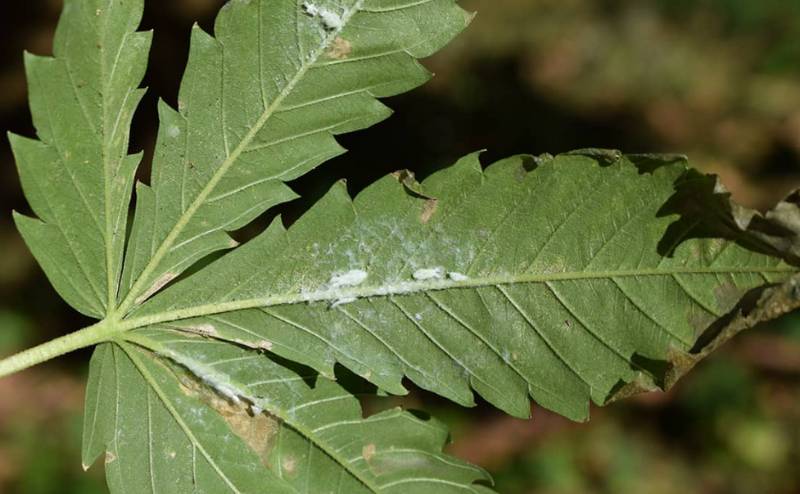
Another reason for rust spots on leaves can be pest infestation.
If your plants get pests, it can cause rust spots or even work as a host of other types of spots.
This plant problem is more likely to affect outdoor plants, but bringing these infected plants indoors can also affect the other plants.
Due to these pests, the leaves of plants can turn yellow or show brown spots.
The good news is that once you figure out pest infestation on your plants, you can treat it quickly. However, you can use neem oil or soap solutions, which will work effectively to remove these.
However, you can read a guide on how to remove pest infestation online.
1. Heat And Light Burn

Apart from these natural issues, heat and light burns are also quite common, which may cause cannabis leaves to curl up and make them appear darker.
The good part is that you can observe it quickly.
Heat and light burns occur due to long hours of keeping lights on and/or keeping grow lights too close to the plants that it causes light burn.
However, heat burn occurs when the temperature in your grow space remains relatively high compared to the optimal range.
The simple solution to avoid heat burn is maintaining the optimal temperature range. On the other hand, you can solve light burns by keeping grow lights at the appropriate distance from the plants.
So, these are the five main reasons your cannabis plants may suffer from rust spots. However, you can find the issues quickly and solve them before severe damage to the plants.
How To Spot Rust Spots On Plant Leaves?
Weed plants or any other plant suffering from rust spot or fungal rust must show some symptoms you must observe.
You can check whether there is a yellow spot on the leaf. These spots can also occur on the upper and lower branches of the stem.
Sometimes, you also observe reddish-brown spots on the plant’s leaf surface during the advanced infection stage.
Therefore, you need to watch these symptoms on middle-aged leaves quickly.
Furthermore, as mentioned before, you can rub your fingers, and if part of the rust rubs against your finger by making color get off the leaves, your plant suffers from fungal rust.
However, if this is not the symptom, you are most likely facing issues related to the nutrients. Therefore, you must check whether the problem is nutrient lockout or deficiency.
So, with these techniques, you can spot rust spots on the plant leaves and take appropriate action before worsening the situation.
Who Has More Risk Of Rust Spots On Leaves During Flowering? Indoor Or Outdoor Growers?
Both indoor and outdoor growers can experience rust spots on the leaves of the plants.
But in some cases, indoor growers are more prone, while in other instances, outdoor growers are more likely to have issues.
For instance, indoor growers are more likely to deal with rust fungus, while outdoor growers are more likely to face pest infestation issues.
Furthermore, indoor and outdoor plants can face issues related to nutrient deficiencies or excessive nutrients.
So it doesn’t matter if you grow plants indoors or outdoors; if you are a grower, you should be better prepared for all the issues.
The good part is that if you maintain your garden well and can figure out issues quickly, along with appropriate solutions, you can eliminate any problem your plant may face.
Frequently Asked Questions Regarding Rust Spots On Leaves
How to fix rust spots on leaves during the flower production phase?
Rust spots happen due to a fungus or nutrient deficiency. Therefore, before you can directly jump to the treatment of your plants, you need to figure out the root cause of rust fungus.
Once you have figured it out, you need to take appropriate action according to the reason. For instance, if you have observed that rust fungus is the issue for rust spots on your plant leaves.
Then you can eliminate the plant and save other plants. Or take fungicides to help beforehand to avoid this issue altogether.
Also, if the plants have rust spots due to nutrient deficiency, you must provide the required nutrients accordingly. Finally, buy a quality nutrient from the market and get started.
What do rust spots on leaves mean?
Rust spots on leaves mean your plant suffers from a disease due to rust fungus or nutrient deficiency.
Rust fungus occurs in wet and humid conditions; therefore, you need to check if the rust fungus is happening in your plant.
Should I cut off leaves with rust?
You can pinch off the rust from infected leaves and remove them from the garden. However, you should not cut more than 1/3rd of the plant leaves at one time.
Rust thrives with water on plant’s leaf surfaces.
Therefore, to remove the rust and prevent the leaves from getting infected, you need to avoid water contact from the surface of plant leaves.
Does rust fungus go away on its own?
No rust fungus does not go away on its own, but rather if left can infect other plants in your garden as well. However, you can take preventive measures for your plants so that it does not give rise to rust fungus.
Why are my leaves turning rusty?
If your leaves are turning rusty, there may be several reasons. First, some primary reasons that cause cannabis leaves to turn rusty are overwatering, rust fungus, and underwatering.
Therefore, you need to figure out the exact reason for it and then work on the solution part.
What fungus causes leaf rust?
The fungus that causes leaf rust is Puccinia Triticina Eriks, formerly Puccinia Recondita. These fungi mainly attack the leaves, so you observe leaf rust.
Is rust damaging to the plants?
Rusting does not kill your plants but can surely damage or weaken them. If you are not paying attention to this issue and finding the appropriate solution, your plants can eventually die.
Therefore, you need to take necessary action ASAP to prevent even more minor damage to your plants.
Avoid Rust Spots On Leaves: Conclusion
Rust spots on the plant leaves occur due to rust fungus, overwatering, pest infestation, and nutrient deficiencies.
If you can figure out by which issue your plant is suffering, you can quickly work on the root cause and eliminate the rust spot issues.
However, to do so, you need to be aware of the reasons and causes that make this issue rise, which you finally know through this guide.
Besides having knowledge, keeping fungicides and using them with appropriate knowledge is always the best practice to avoid rust spots on plant leaves during flowering.

